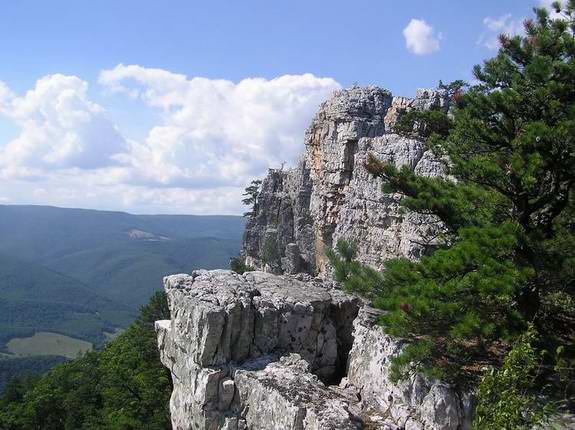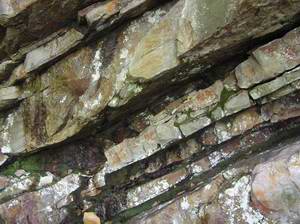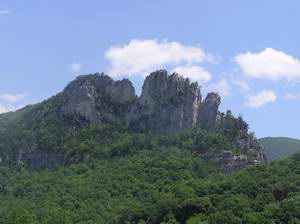|
Return to Hiker's Notebook Home Page
Tuscarora Formation
The Tuscarora Formation is named for Tuscarora Mountain in Central Pennsylvania where it was first described. The Tuscarora were a Native American tribe originally inhabiting the Roanoke, Pamlico and Neuse River basins in what is now eastern North Carolina. The name means "hemp gatherers" and refers to their purportedly extensive use of the plant Apocynum cannabinum, which is commonly known as Indian hemp, dogbane (for its toxic properties) or rheumatism root (for its medicinal properties). The Tuscarora Indians were forced to flee northward after two unsuccessful uprisings against North Carolina colonists between 1711 and 1713. The discontinuous migration took about 90 years altogether and involved numerous interim settlements, one of which was the area of their namesake mountain. The Tuscarora Indians were eventually incorporated into the Five Nations of the League of the Iroquois in New York.
The primary and most distinctive constituent of the Tuscarora Formation is metamorphosed quartzite known as metaquartzite. Quartzite can be either sedimentary or metamorphic depending on its provenance. In both cases, it originates as quartz-rich sandstone, a sedimentary rock formed by the gradual eroding of upland rocks that are transported as sediment to form alluvial deposits in riparian (river) and neritic (ocean shore) regions. Quartz (SiO2) is the second most abundant of earth's minerals after feldspar and is accordingly a primary constituent to all sedimentation. If the sandstone is subsequently subjected to lower temperatures and pressures, it retains is sedimentary character, and the resultant quartzite is known as orthoquartzite. There is a subtle distinction between orthoquartzite and quartz-based arenites (sandstones), the former distinguishable according to its mode of fracture across rather than around grain boundaries. If the quartz-rich sandstone is subjected to high temperatures and pressures, the metamorphic metaquartzite results.
Secondary and tertiary constituents of the Tuscarora Formation include interbedded sandstone, siltstone and shale with local pockets of conglomerate. Sandstone is medium-grained rock that it is formed by loose material called detritus that results directly from the disintegration of rock. It is also known as a clastic rock as it is made up of broken (Greek klastos) fragments. Sandstones are classified according to the type of rock from which the sandstone particles are derived: arkose contains feldspar and is generally a consequence of weathering granite; graywacke is comprised of assorted rock fragments and minerals; subgraywacke is graywacke having a higher proportion of quartz; and orthoquartzite, as discussed above, is predominantly quartz. Sand-sized rock fragments in the range of .02 mm to 2 mm become sandstone when they are compressed by overlying sediments and infiltrated by cementitious materials such as calcium carbonate and silica that bind the grains into a solid matrix.
Siltstones and shales are comprised of rock fragment particles that are smaller than sandstone (< .02 mm) in addition to flakes of clay (< .002 mm). Silt is primarily comprised of silicon dioxide; clay contains aluminum in addition to silicon and oxygen. Both sedimentary rock types are formed from the terrestrial erosion and disintegration of igneous, metamorphic or previously deposited and uplifted sedimentary rocks. The smaller size particles result when the larger sand-sized particles precipitate closer to the riparian source while the silt-sized particles remain in solution. Shore-line beaches are comprised of sand while the off-shore marine sediments are comprised of silt. Shale is essentially siltstone that has fissility which means that it can be broken into thin sheets, a property attributed to the alignment of plate-like minerals such as mica. Shale that is metamorphosed becomes slate which, under continued metamorphism, becomes phyllite and ultimately schist and gneiss.
According to the geological principle of uniformitarianism established by James Hutton in the seminal 1795 work "Theory of the Earth" and popularized in 1833 by Charles Lyell in "Principles of Geology," the rocks that comprise the Tuscarora Formation are an indicator of the geologic processes that brought about their deposition. Its various quartzite, sand/silt stone and shale constituents indicate a beach/shore provenance that extended over a significant geologic time period; the Tuscarora Formation is over 900 feet thick in Pennsylvania and ranges from about 50 to 400 feet thick in the remainder of its range of Maryland, Virginia and West Virginia. Relatively recent comprehension of the movements of the large plates (called plate tectonics) that comprise the Earth's crust provide a credible explanation for the observed strata and their compositions.
The Grenville orogeny occurred about 1.2 Billion years ago when the supercontinent Rodinia was formed from the individual constituent continental plates, its mountain building establishing the bedrock of the Appalachian Mountains. About 800 million years ago Rodinia broke apart, a phenomenon theoretically attributed to the build up of heat under the singular land mass that ultimately led to the rifting of the individual tectonic plates. This resulted in the opening of the Iapetus Ocean between the protocontinents Laurentia (North America and Greenland), Baltica (Scandinavia and Northern Europe) and Gondwana (Africa, South America, Eurasia, Australia and Antarctica). The eponymous Iapetus Ocean is named for the titan Iapetus, who was the father of Atlas in Greek mythology; the Atlantic Ocean is named for Atlas, and the Iapetus Ocean is essentially a proto-Atlantic Ocean.
The cyclic convergence and divergence of the
tectonic plates continued about 500 million years ago in the Cambrian Period
of the Paleozoic Era when the Iapetus Ocean began to close. It is hypothesized
that one or two microcontinent island arcs formed off the coast of Laurentia
that could have been either a string of volcanic islands that arise at the
edges of plates (like the Aleutian Islands) or crustal fragments broken away
from another landmass such as Gondwana. As the Eurasian Plate and the North
American Plate continued to move together, these off-shore land masses
collided with Laurentia in what is known as the Taconic Orogeny in the
Ordovician Period
The Taconic Orogeny created the Appalachian Basin,
an inland sea syncline that extended along the entire eastern side of
Laurentia. The erosion of the Taconic Mountains to the west over a period of
some 100 million years during the Silurian, Devonian and Carboniferous Periods
resulted in the deposits of quartz and feldspar sediments that consolidated
to become the Tuscarora formation on top of the Juniata Formation. The
sandstones formed along the shore, and the siltstones and quartzites at some
distance from the shore. As the Atlantic and North American plates continued
to
|

 about 460 million years ago. This resulted in an uplifting of the Taconic
Mountains along the east coast of Laurentia and the creation of an inland sea
to the west. The geologic record of this progression is a molasse, which is a
combination of conglomerates and sandstones that form as non-marine deposits
at the base of rising mountain chains. The Juniata Formation (right) the name
given to the molasse formation that underlies the Tuscarora Formation. It is
made up of layers of greenish-gray siltstone with interbedded conglomerate
that resulted from the collision of the two land masses.
about 460 million years ago. This resulted in an uplifting of the Taconic
Mountains along the east coast of Laurentia and the creation of an inland sea
to the west. The geologic record of this progression is a molasse, which is a
combination of conglomerates and sandstones that form as non-marine deposits
at the base of rising mountain chains. The Juniata Formation (right) the name
given to the molasse formation that underlies the Tuscarora Formation. It is
made up of layers of greenish-gray siltstone with interbedded conglomerate
that resulted from the collision of the two land masses.  move
together, the embedded land masses consolidated in the supercontinent Pangaea,
and the resultant Acadian and Alleghenian Orogenies uplifted the sediments of
the Tuscarora Formation. Subsequent erosion removed the softer overlying
materials to reveal the resistant metaquartzite strata, in some cases bent
almost vertically by the irresistible forces of the moving land masses. Seneca
Rocks in West Virginia (left) is one of the most dramatic examples of this.
move
together, the embedded land masses consolidated in the supercontinent Pangaea,
and the resultant Acadian and Alleghenian Orogenies uplifted the sediments of
the Tuscarora Formation. Subsequent erosion removed the softer overlying
materials to reveal the resistant metaquartzite strata, in some cases bent
almost vertically by the irresistible forces of the moving land masses. Seneca
Rocks in West Virginia (left) is one of the most dramatic examples of this.